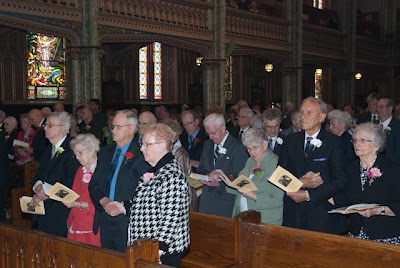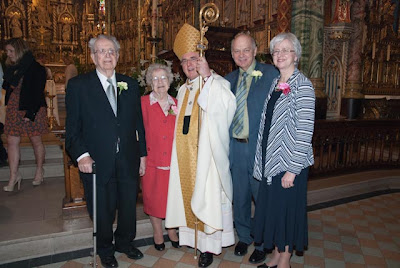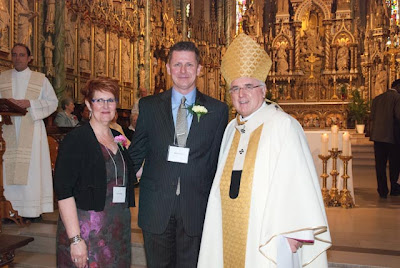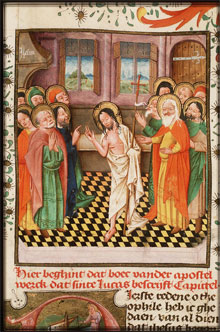Bienheureuse Kateri Tekakwitha
Modèle de la première évangélisation et de la nouvelle évangélisation
Par le Père Thomas Rosica, C.S.B.
Lors de la Journée mondiale de la Jeunesse (JMJ) en 2002, à Toronto, il y a 10 ans, le bienheureux Jean-Paul II s’est adressé aux milliers de jeunes rassemblés sur la base militaire, à Downsview, le dimanche 28 juillet 2002, durant la messe qui clôturait cette rencontre bénie :
« Dans les moments difficiles de l'histoire de l'Église, le devoir de la sainteté devient encore plus urgent. Et la sainteté n'est pas une question d'âge. La sainteté, c'est vivre dans l'Esprit Saint, comme l'ont fait Kateri Tekakwitha, ici en Amérique, et de nombreux autres jeunes. »
Pour sa dernière JMJ, le bienheureux Jean-Paul II a choisi une jeune femme amérindienne, une des neuf jeunes saints et bienheureux qu’il a offerts au Canada en tant que patrons des JMJ 2002, comme modèles de sainteté, de bonté, d’humanité pour des millions de jeunes qui étaient et restent partie prenante de la grande aventure de la JMJ. La vie de Kateri est une curieuse histoire. Nous avons peu de paroles d’elle dans ses biographies. Qu’est-ce qui a poussé Kateri à être baptisée? Quelle fut la source de son amour de Jésus-Christ et de l’Église? Comment la vie de cette amérindienne du 17e siècle peut-elle parler aujourd’hui à la société, à la culture contemporaine et à l’Église? Comment sa foi et sa canonisation guériront-elles les peuples des Premières Nations, meurtris par les histoires d’abus, d’oppression et de discorde?
Réfléchissons à la vie de la future sainte Kateri Tekakwitha, pour voir ce qu’elle peut effectivement nous offrir. Son histoire nous est racontée dans des biographies vieilles de plusieurs centaines d’années, écrites par deux pères jésuites qui la connaissaient et priaient avec elle alors qu’ils étaient responsables de la mission Kahnawake, les pères Pierre Cholenec et Claude Chauchetière. Leurs témoignages écrits mettent en valeur la vie vertueuse de Kateri, son vœu de chasteté, la haine du péché et de soi-même, et ses pratiques extrêmes de repentance jusqu'à sa mort à l’âge de 24 ans.
Kateri Tekakwitha, connue comme le « Lys des Mohawks » et la « Geneviève de la Nouvelle-France » est née en 1656, à Ossernenon, un village iroquois sur la rivière Mohawk, dans ce qui est l’état de New York. Ce lieu est connu aujourd’hui sous le nom d’Auriseville, New York. Son nom iroquois ‘Tekakwitha’ est souvent prononcé tek’u-kwith’u. Le père de Tekakwitha était un chef Mohawk et sa mère une Algonquine catholique.
Alors que Tekakwitha a quatre ans, son village fut ravagé par la variole, emportant ses parents et son frère bébé et la laissant orpheline. La variole a laissé des traces sur son visage, et a sérieusement altéré sa vue. Bien que gravement affaiblie, traumatisée et partiellement aveugle, Tekakwitha a survécu et fut adoptée par ses deux tantes et son oncle, un chef Mohawk. La famille quitta son village et construisit un nouvel hameau, appelé Caughnawaga, à 5 miles au nord de la rivière Mohawk, qui est aujourd’hui à Fonda, dans l’état de New York.
Tekakwitha n’a pas été baptisée très jeune, pourtant elle avait de tendres souvenirs de sa chère et priante mère et des récits de la foi catholique que sa mère partageait avec elle durant son enfance. Ces souvenirs sont restés imprégnés dans son esprit et son cœur et ont influencé la suite de sa destinée. Elle allait souvent seule dans les bois pour parler à Dieu et l’écouter dans son cœur.
Lors des dix-huit ans de Tekakwitha, le père de Lamberville, missionnaire jésuite, vint à Caughnawaga, et fonda une chapelle. Son oncle n’aima pas « la robe noire », et son étrange religion, mais il toléra la présence du missionnaire. Kateri se souvenait vaguement des prières murmurées par sa mère, et était fascinée par les nouvelles histoires qu’elle entendait sur Jésus-Christ. Elle voulut en savoir plus sur Lui et devenir chrétienne. Le Jésuite persuada l’oncle de la jeune fille de lui permettre de suivre des cours d’instruction religieuse. La fête de Pâques suivante, à 20 ans, Tekakwitha fut baptisée. Elle reçut le nom de ‘Kateri’, qui veut dire Catherine en mohawk. Tekakwitha en Iroquois signifie « Une qui place des choses en ordre » [Mettre tout en place].
La jeune baptisée devint intensément dévote, et elle s’exposait délibérément à la douleur du froid, aux brûlures du charbon chaud, et se perçait la peau avec des épines pour imiter les souffrances du Christ. La famille de Kateri n’acceptait pas son choix de suivre le Christ. Malgré la beauté du récit de sa foi si sincère et si fervente, l’époque et l’environnement qui l’entouraient n’étaient certainement pas idylliques. C’était au temps de la colonisation, d’une terrible guerre opposant les peuples iroquois et algonquins, et de l’hostilité des autochtones américains envers les missionnaires qui accompagnaient les européens pour le commerce de la fourrure. Après son baptême, Kateri devint bannie de son village. Sa famille refusait de la nourrir les dimanches car elle refusait de travailler. Les enfants la raillaient et lui lançaient des pierres. Elle était menacée de torture et de mort si elle ne renonçait pas à sa religion.
À cause de l’hostilité grandissante des gens de son peuple, et parce qu’elle voulait consacrer sa vie à Dieu, en juillet 1677, Kateri a quitté son village et a fui à plus de 200 miles (322 km) à travers les bois, les rivières, les marécages jusqu'à la mission catholique de St-Francois-Xavier, à Sault Saint-Louis, à côté de Montréal. Le voyage de Kateri à travers les étendues sauvages a duré plus de deux mois. Grâce à sa détermination de se prouver qu’elle était digne de Dieu et grâce à sa foi profonde elle a eu le droit de recevoir sa première communion le jour de Noël, en 1677. Sur les rives du fleuve Saint-Laurent au Canada, Kateri vécut dans la cabane d’Anastasia Tegonhatsihonga, une autochtone chrétienne ; son extraordinaire sainteté impressionnait non seulement ses congénères, mais aussi les Français et les missionnaires. Ses mortifications étaient extrêmes, et beaucoup disaient qu’elle avait atteint l’union la plus parfaite avec Dieu dans la prière.
La devise de Kateri devint, « Qui est-ce qui m'apprendra ce qu'il y a de plus agréable à Dieu afin que je le fasse? » Elle passait beaucoup de son temps en prière devant le Saint-Sacrement, à genoux dans la chapelle si froide, durant des heures. Kateri aimait prier le chapelet, et le portait toujours autour de son cou. Kateri enseignait aux jeunes et aidait les pauvres et les malades de son village. Sa dévotion préférée était de construire des croix avec des bouts de bois et les laisser dans la forêt. Ces croix étaient des stations qui lui rappelaient de passer un moment en prière.
Pourtant, même dans le village chrétien iroquois de Kahnawake, les pressions liées aux attentes culturelles, comme le mariage et la participation dans certaines pratiques aborigènes, persistaient. Le 25 mars 1679, Kateri fit le vœu de virginité perpétuelle, signifiant qu’elle ne se marierait jamais, et serait totalement loyale au Christ pour le reste de sa vie. Kateri désirait créer un couvent pour les sœurs aborigènes américaines à Sault St-Louis mais son directeur spirituel, le Père Pierre Cholonec la découragea. La santé de Kateri, toujours fragile, déclinait rapidement, due surtout aux pénitences qu’elle s’infligeait. Le Père Cholonec encourageait Kateri à prendre mieux soin d’elle, mais elle riait et continuait avec ses « actes d’amour ».
On observe la mémoire de Bienheureuse Kateri aujourd'hui parce qu'elle est morte à l’âge de 24 ans,
le 17 avril 1680, le mercredi de la semaine sainte, à 15 heures. Ses derniers mots furent : « Jesos Konoronkwa » [Jésus je t’aime]. Quinze minutes après sa mort, devant le regard de deux Jésuites et de tous les Amérindiens que la pièce pouvait contenir, les horribles cicatrices de son visage ont soudainement disparu. Ce miracle a été vu par les deux Jésuites, et tous ceux présents dans la pièce.
L’ambiance et la scène de la mort de Kateri continuent à toucher encore aujourd’hui. Nous devons lire les récits émouvants des Pères Claude Chauchetiere et Pierre Cholenec, qui était le supérieur de la mission de Saint-François-Xavier, lorsqu’ils ont été déplacés à Kahnawake, en 1716.
La cloche de la chapelle sonna à 15 heures pour réunir les Autochtones, parce qu’ils désiraient assister à sa mort. Après 15 heures, ils s’y rendirent et Kateri Tekakwitha attendit que tout le monde soit dans la pièce. Lorsque le dernier arriva, elle rentra en agonie avec tout le monde à genoux autour d’elle. Une petite demi-heure après son agonie, elle prononça ses derniers mots : « Iesos! Wari! » [Jésus! Marie!].
Puis elle eut un petit spasme au côté droit de sa bouche. Elle mourut comme si elle rentrait dans un sommeil léger et pendant longtemps nous n’étions pas certains de sa mort. Un peu avant 16 heures, son visage soudainement changea et devint en un instant tellement beau, souriant et blanc. Son visage prit une teinte légèrement rosée, qu’elle n’avait jamais eue auparavant, et ses traits furent différents. Je le vis immédiatement car je priais juste à ses côtés, et j’en poussais un cri d’étonnement. Son visage avait été tellement marqué par les cicatrices de la variole depuis l’âge de quatre ans, ses infirmités et mortifications ont aggravé encore plus son état. Avant sa mort, son teint devint plus foncé. Son visage apparut plus beau que lorsqu’elle était en vie. Je confie volontiers la première pensée qui m’est venue à l’esprit, que Kateri venait peut-être d’entrer au paradis à ce moment.
Nous avons vécu le jour de la mort de Kateri avec une très grande dévotion. Elle a quitté le village entier laissant à sa suite un parfum de sa vertu et de sa sainteté, surtout lorsque plusieurs heures plus tard je prononçais son oraison funèbre lors des prières du soir, je rappelais aux Amérindiens le trésor qu’ils possédaient puis avaient perdu avant qu’ils ne la connaissent. Kateri Tekakwitha est morte comme qu’elle a vécu, c’est-à-dire une sainte. C’était prévisible qu’une telle vie sainte soit suivie d’une mort sainte, parce que Kateri Tekakwitha était remplie de l’Esprit Saint. La simplicité des autochtones leur a fait faire plus que requis lors de cette occasion, comme lui embrasser les mains, garder tout ce qui lui appartenait comme reliques, passer la soirée et le reste de la nuit à ses côtés pour admirer son visage. Son expression inspirait la dévotion même si son âme était séparée d’elle. C’était un nouvel argument crédible que Dieu offrait aux Amérindiens pour leur faire goûter la foi.
Le 22 juin 1980, lors de sa béatification en la basilique Saint-Pierre, le pape Jean-Paul II a décrit Kateri avec ces mots :
“Lorsque sa famille l’a poussée à se marier, elle répondit avec beaucoup de calme et de sérénité que seul Jésus serait son époux. Cette décision, dans le contexte de l’époque des femmes autochtones, était un risque réel pour elle de vivre en proscrite et dans la pauvreté. C’était un geste intrépide, peu commun, et prophétique : le 25 Mars 1679, à l’âge de 23 ans, avec l’accord de son directeur spirituel, Kateri a fait vœu de virginité, et le plus loin que l’on s’en souvienne, ce fut la première fois que cela se voyait chez les Indiens d’Amérique de Nord.
Les derniers mois de sa vie furent une manifestation encore plus claire de sa foi très solide, de sa franche humilité, de sa calme résignation, et de sa joie radieuse, même au beau milieu de terribles souffrances. Ses derniers mots, simples, sublimes, murmurés au moment de sa mort, résumèrent, tel un noble hymne, une vie empreinte de charité pure : « Jésus, je t’aime ».
S’adressant aux Autochtones d’Amérique du Nord, juste après sa béatification, le 24 juin 1980, le pape Jean-Paul ll a dit :
« Vraiment la bienheureuse Kateri se dresse devant nous comme le meilleur symbole du patrimoine qui est le vôtre, indiens d’Amérique du Nord. L’Ėglise a déclaré au monde que Kateri Tekakwitha est bienheureuse, que sa vie sur terre fut un exemple de sainteté et que maintenant, au paradis, elle est membre de la communion des saints qui sans cesse intercèdent pour nous auprès du Père miséricordieux.
Sa béatification devrait nous rappeler que nous sommes tous appelés à une vie de sainteté, qu’avec le baptême, Dieu a choisi chacun de nous à « être saint et immaculé et à vivre à travers son amour ». La Vie de sainteté – l’union avec le Christ à travers la prière et l’exercice de la charité – n’est pas réservée à une élite choisie parmi les membres de l’Église. C’est la vocation de tous. »
Et plus récemment, le pape Benoit XVI a mentionné ce grand modèle de sainteté lorsqu’il s’est adressé aux jeunes et aux séminaristes du Séminaire St Joseph à Yonkers, New-York lors de sa visite historique aux États-Unis, le 19 avril 2008.
« Sainte Elizabeth Ann Seton, sainte Françoise-Xavière Cabrini, saint John Neumann, la bienheureuse Kateri Tekakwitha, le vénérable Pierre Toussaint et le Père Felix Varela: n'importe qui d'entre nous pourrait être parmi eux, parce qu'il n'y a aucun stéréotype dans ce groupe, aucun modèle uniforme. Mais à y regarder de plus près, ils ont des éléments communs. Embrasées par l'amour de Jésus, leurs vies sont devenues de remarquables voyages d'espérance. Pour certains, cela voulait dire quitter leur maison et s'embarquer pour un pèlerinage de milliers de kilomètres. Pour chacun d'eux, il y a eu un acte d'abandon à Dieu, avec la confiance qu'il est la destination finale de tout pèlerin. Et ils ont tous offert une main tendue d'espérance à ceux qu'ils rencontraient sur leur chemin, en éveillant souvent en eux la vie de la foi. Par des orphelinats, des écoles et des hôpitaux, en se faisant amis des pauvres, des malades, et des marginaux, et par le témoignage convaincant qui vient du fait de marcher humblement sur les pas du Christ, ces six personnes ont ouvert la voie de la foi, de l'espérance et de la charité à un nombre incalculable de personnes, y compris peut-être vos propres ancêtres. Kateri parle à notre génération. »

Le 22 juin 1980, Kateri Tekakwitha a été béatifiée comme la première amérindienne américaine par le pape Jean-Paul ll. Sa fête est célébrée le 14 juillet aux États-Unis, et le 17 avril au Canada. Le 21 octobre 2012, elle sera la première indienne d’Amérique du nord à être canonisée. Elle parle aux souffrants, aux persécutés, et aux affligés. Ses racines s’étendent des États-Unis au Canada, aux deux communautés française et anglaise. Kateri représente parfaitement l’Ecclesia en Amérique. Elle est un pont merveilleux de guérison et réconciliation pour notre monde contemporain et l’Église – un vrai symbole des liens forts entre les catholiques et nos frères et sœurs autochtones de nos terres.
En tant que modèle de chasteté et de pureté, Kateri est un guide sûr, nous enseignant comment vivre notre sexualité avec plaisir et en respectant le plan d’amour de Dieu. L’exemple de Kateri nous apprend que le corps est la porte d’entrée du salut, et donc la façon dont nous le traitons est important. Si nous ne pouvons pas dire « non » alors notre « oui » ne signifiera rien. Plus nous acceptons la chasteté et en faisons notre ligne de conduite, plus notre entourage sentira que l’Esprit Saint nous habite. Lorsque nous vivons notre sexualité de façon correcte, en accord avec notre état de vie, les autres seront capables de trouver Dieu en nous.
Et enfin, en tant que patronne de l’écologie et de l’environnement, Kateri nous enseigne comment aimer et respecter la création, et comment en prendre soin. Sa vie terrestre était méconnue au 17e siècle, et pourtant son message continue à retentir à travers les époques, nous rappelant qu’une vie chrétienne et son message sont bons, beaux, saints, et durables. De son vivant, Bienheureuse Kateri Tekakwitha était un instrument de la première évangélisation. À travers sa mort, et son adhésion à la communion des saints, elle est un modèle éternel de la nouvelle Évangélisation pour l’Église.
(Cet article est paru dans l’édition anglaise de l’Osservatore Romano, le 7 mars 2012)
* * * * * *
MASS FOR THE NEOPHYTES
A few days ago, I received this latest book by Garry Wills on baptism in the early Church in Milan (Font of Life: Ambrose, Augustine and the Mystery of Baptism, published by Oxford and available yesterday in Canada--it was available two weeks earlier in the USA).
It was good preparation for the Mass of the Neophytes (those fully initiated into the Life of Christ by baptism, confirmation and Eucharist at the Easter Vigil) celebrated Sunday morning at Notre Dame Cathedral Basilica. As in past years, the Mass was followed by my guided tour for the newly initiated and others who wished to take part.
We viewed the statuary and decoration of the cathedral sanctuary and, afterwards, a visit to the treasures of the archdiocese displayed in the sacristy. Jean-Claude Grant took these pictures, which he shared with me:







































